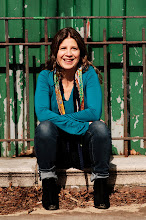“I turned, at that point, to John Bowlby, known principally for his work on the mother-child attachment, but who also had seminal insights into the relationships between people and their near environments. Bowlby thought this near environment so important, he called it ‘an outer ring of homeostatic mechanisms,’ as important to life support as the physiological homeostasis inside the human body. In Bowlby’s terms, this near environment was an important object of attachment.”
-from The House of Joshua, by Mindy Thompson Fullilove
Mindy was one of my professors and mentors (my only mentor, really) when I was getting my MPH at Columbia. She’s probably the most original thinker I’ve ever encountered. When I went to her classes, I used to silently pray for my fellow classmates to stop yammering…because it was so much more interesting to hear Mindy talk. (They never did. Oh well.)
Anyway, I didn’t have Mindy or her work on the psychology of place in mind when I started noodling around with the Louisiana idea, but somehow all roads seem to lead back to her. I’m totally fascinated with her comment, above, which appeared in her first book, The House of Joshua, in which she explores the place stories of her own family.
Her later work has focused a lot on urban renewal and the physical displacement of African American communities, and the destruction that wrought—psychologically and physically—on these people and their descendents. More recently she’s been drawn into stories like the post-911 mess, which she called “an attack upon the landscape,” and Hurricane Katrina.
But I digress. John Bowlby was a British psychologist who among the first to get the field away from notions of Freudian fantasies and talk about relationships as the foundation for who we are. I read and thought a lot about his work when I was working on The Empty Room, because I was interested in the notion of siblings as attachment figures. (I believe they are, but Bowlby and most psychologists since still focus on the mother-child bond. Wrongly, I think—but that’s another story entirely.)
Bowlby’s idea, in a very small nutshell: Secure, stable parents and secure stable bonds create secure stable “attached” kids. Anxious, depressed parents create the opposite kind of parent-child bonds and poorly attached kids.
But what if we extend the figure of attachment to include a place—the home where you grew up, the hometown where you grew up? What happens to you—emotionally, and in terms of your identity-- if you move away or they get destroyed? What happens if your environment is unstable?
It’s interesting, when you start thinking about how mobile our society is….And when you start thinking about next generations, and “homes” in generic suburbs that sprang out of nothing…what impact does the moving, the loss of ancestral environments and growing up in placeless suburbs have on us?
MineMineMine!
13 years ago




1 comment:
I'm fascinated by such explorations into the meaning of place and identity. My childhood was marked by lots of detachment from place. In some ways, I had no sense of home. I'm figuring out how being in boarding school from first to third grades, plus moving often, staying at places other than home, having divorced parents (they split when I was 3),etc., have shaped me. In adulthood, I've become a major homebody.
Delia
girlssentaway.wordpress.com
Post a Comment